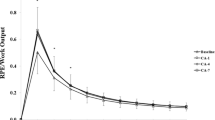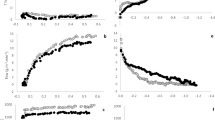Abstract
The purpose of this study was to evaluate the effect of exercise on the subsequent post-exercise thresholds for vasoconstriction and shivering measured during water immersion. On 2 separate days, seven subjects (six males and one female) were immersed in water (37.5°C) that was subsequently cooled at a constant rate of ≈6.5°C · h−1 until the thresholds for vasoconstriction and shivering were clearly established. Water temperature was then increased to 37.5°C. Subjects remained immersed for ≈20 min, after which they exited the water, were towel-dried and sat in room air (22°C) until both esophageal temperature and mean skin temperature (T¯ sk) returned to near-baseline values. Subjects then either performed 15 min of cycle ergometry (at 65% maximal oxygen consumption) followed by 30 min of recovery (Exercise), or remained seated with no exercise for 45 min (Control). Subjects were then cooled again. The core temperature thresholds for both vasoconstriction and shivering increased significantly by 0.2°C Post-Exercise (P < 0.05). Because the T¯ sk at the onset of vasoconstriction and shivering was different during Pre- and Post-Exercise Cooling, we compensated mathematically for changes in skin temperatures using the established linear cutaneous contribution of skin to the control of vasoconstriction and shivering (20%). The calculated core temperature threshold (at a designated skin temperature of 32.0°C) for vasoconstriction increased significantly from 37.1 (0.3)°C to 37.5 ( 0.3)°C post-exercise (P < 0.05). Likewise, the shivering threshold increased from 36.2 (0.3)°C to 36.5 (0.3)°C post-exercise (P < 0.05). In contrast to the post-exercise increase in cold thermal response thresholds, sequential measurements demonstrated a time-dependent similarity in the Pre- and Post-Control thresholds for vasoconstriction and shivering. These data indicate that exercise has a prolonged effect on the post-exercise thresholds for both cold thermoregulatory responses.
Similar content being viewed by others
Author information
Authors and Affiliations
Additional information
Accepted: 22 December 1998
Rights and permissions
About this article
Cite this article
Kenny, G., Denis, P., Proulx, C. et al. The effect of dynamic exercise on resting cold thermoregulatory responses measured during water immersion. Eur J Appl Physiol 79, 495–499 (1999). https://doi.org/10.1007/s004210050543
Issue Date:
DOI: https://doi.org/10.1007/s004210050543




